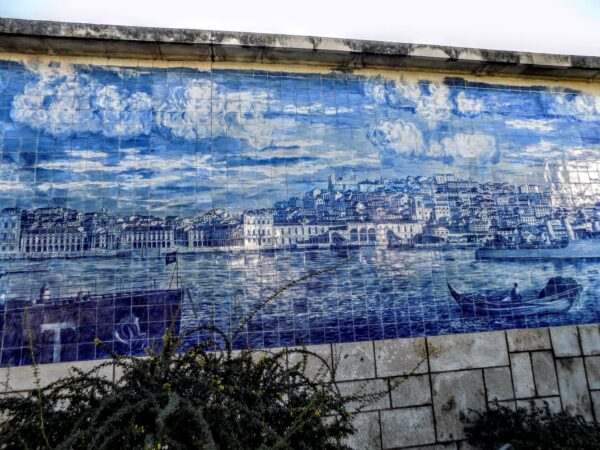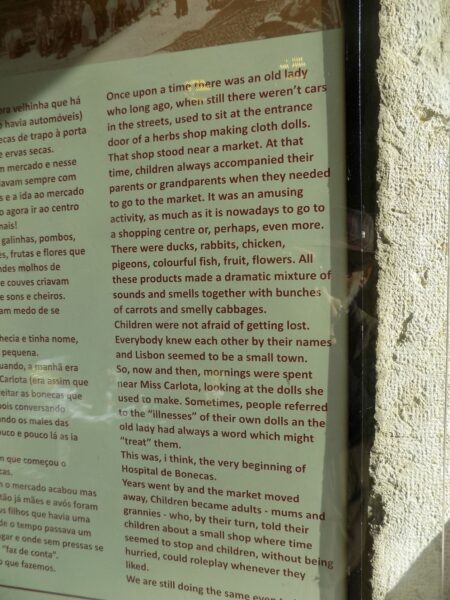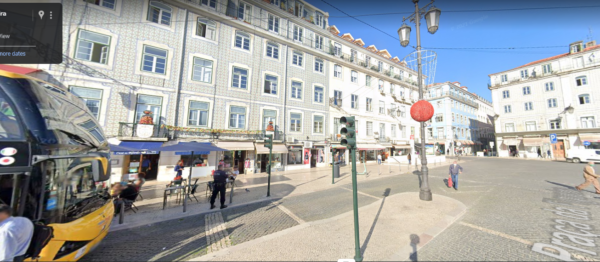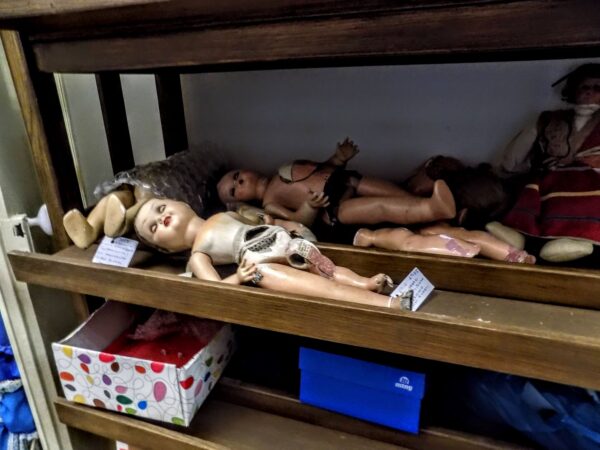But first, another etymological detour.
In its blurb about the comic strip history mural, Atlas Obscura writes, “If you’re lucky, you’ll even encounter a tour guide with a small group of visitors and can eavesdrop on what they’re being told about this piece.” In this sense, I was lucky and unlucky. I encountered a tour guide with a small group of visitors (some of whom you can see in the last photo in the previous post) and was able to eavesdrop on what he was telling them. I was unlucky in the fact that whatever he was telling them was in German.
However, he and I managed to briefly chat while his group was busy taking selfies or using the toilet. He said something interesting that makes some sense but that I can’t confirm. We talked a little about the quality of the light that permeates the city and he said that the city’s name – Lisboa – referenced that ‘good light’. The Portuguese word meaning light is luz and good is boa and one can easily see how, in speech, luz+boa could become Lisboa. But there are a few problems with this etymological assertion – the most obvious being that in Portuguese adjectives usually precede nouns. Thus, good light in Portuguese is boa luz not luz boa. Other issues are that the Romans called the place Olisipo and when the Visigoths arrived in the fifth century in their Germanic tongue Olisipo became Ulishbona. So, while the guide’s interpretation might be a romantic one, it’s probably not the most accurate. After a brief adieu, we waltzed away from one another.
Meanwhile, from the Miradouro de Santa Luzia, you have views of that good light whether you’re looking toward the river

or farther up the hill toward the Sāo Vicente de Fora Church and one of Lisbon’s two pantheons,

or even at the nearby portrait of Lisboa in azulejos. I think it was at this time that I began to hear the city whisper, “Mas disso eu tenho certeza: você voltará novamente.” (But this I know for certain: You will return again.)

I decided to start back down the hill and actually take my tour of the Hospital de Bonecas. I expected this would take a few minutes longer because, as I noted previously, most of my time walking downhill in Lisboa required more focus than walking uphill.
I won’t reproduce the history of the Doll Hospital but you can read it by enlarging the photo below with a click

or by using this link.
Nestled among a string of stores on the Praça da Figueira

is the unassuming storefront of the Hospital de Bonecas – the Dolls Hospital. (In the screen capture from Google Maps above, the blue awnings belong to the Casa das Bifanas {bifanas are a traditional Portuguese pork sandwich} and the second tan awning to the right is a jewelry store. The Hospital de Bonecas is between them.)
The first floor is a store where you can find a plethora (Testudo Times shoutout!) of dolls for sale.

But, pay a mere two euros, and you’ll be guided into the hospital itself. My guide, Elizabete, explained that the hospital was established in 1830 by Dona Carlota and that it has remained in the same location managed by the same family in the nearly two centuries since. The hospital repairs dolls from any time period and of nearly any material from cloth to porcelain to plastic.
Parents bring their children to the hospital where chief of staff Manuela Cutileira performs a sort of triage in which she assesses each patient’s status. In a 2018 interview Manuela told NPR, “First we do a checkup, create a chart and assign a bed number – like you would in an ordinary hospital.

“Then we try to figure out what the treatment should be. If it’s a simple procedure, we’ll inform the family right away of the cost. And if it’s something more complicated, they may have to leave the patient here overnight for more tests.”
The cost of treatment can range from as little as five euros to several hundred depending on the nature and complexity of the surgery required. “You never break a doll the same way, it’s exactly like people – your headache is not the same as someone else’s. So we assess each unique problem and give a price on the estimated hours it will take. We repair around 40 dolls a week, and mostly for children, not collectors,” Manuela’s daughter Catarina told The Guardian.
Keeping a sterile environment isn’t essential to the doll’s restoration so it’s likely that you’ll be able to observe someone on the medical staff in the middle of performing surgery or providing treatment.

In addition to the dolls that are repaired and sent home, the hospital houses one of the largest permanent doll collections in the world – ranging from 19th-century German celluloid dolls, to collector’s edition Barbies, to some of the oldest known multiracial dolls from Portugal’s African colonies.

Still, as the younger Cutileira told NPR, “We are a hospital, and all patients are valuable to us. They’re all treated equally. We know we have lots of dolls here that are valuable, but they’re all the same to us. You can’t put a value on your sentiments.”
You can watch a little video featuring Manuela (about two minutes) at The Culture Trip.
Some thoughts on Baixa.
In the planning stages of this trip, I’d emailed Ana (my guide from the walking tour in the spring) and asked her where she would live in Lisboa if cost wasn’t a factor. She suggested four neighborhoods – one of which I was considering, one that I looked into, and two that demanded a little more research. Heading her list was Principe Real (seen outlined in red in the Google Maps screen capture below).

While I didn’t ask her which part of this comparatively large and sprawling neighborhood she had in mind, my guess is that she was probably thinking of the area near the Botanical Garden or perhaps near the Jardim da Estrela as opposed to the southern edge near Restauradores because the latter is much more commercial and is, in fact, quite close to Baixa. Still, it’s reasonably central and more likely to generate a more “authentic” living experience in Lisboa.
In the end, though, I opted for Baixa and by the end of my first week was quite happy I did. First, as I’ve mentioned previously, the neighborhood is a grid – think Midtown Manhattan – whereas many of Lisbon’s other neighborhoods – particularly the older ones – are more like lower Manhattan with streets running off at unpredictable angles. This makes Baixa easier to learn and navigate.
Next, as I have also mentioned elsewhere, Baixa is one of the few flat neighborhoods in the city. I’ve already written about my daily 10 km (about 6.2 miles) walks. Being in Baixa meant that while hilly walks were always nearby, the flat neighborhood was just outside my door. My choice.
One aspect of Baixa that might make it seem a bit less authentic is its popularity with tourists. This almost certainly results in a greater density of VRBO and Air BnB units than you’d find in neighborhoods like Principe Real, Campo do Orique, Prazeres, or Alvalade. When your neighbor is as likely to be a tourist as a Lisboeta, your experience will lack some degree of authenticity.
On the other hand, I discovered that this conveyed several advantages – at least for me. It’s central location meant a lot of places I wanted to see were within a walkable distance and if they weren’t, there was enough density of public transportation that I had an easy alternative. Next, because the area caters to so many tourists, few restaurants follow the Portuguese tradition of closing from 15:30 to 19:30 which allowed me to eat dinner at the very un-Portuguese hour of 19:00 should I so choose. (Although I have to admit this sometimes made me feel like some old codger in south Florida seeking out the Early Bird Special.)
But perhaps most appealing of all is that while Baixa has a remarkable density of restaurants it has very few nightclubs. Thus, in my experience, this made the neighborhood “allegro ma non troppo.” I’ll let Sam Wannamaker as Andrew Erskine explain:
People like me might eat early but even for those who adapt to the Portuguese dinner time of 21:00 (or later), there’s plenty of foot traffic until midnight when things wind down and some restaurants are closing. Those who are inclined to party the night away – be they tourists or Lisboetas – have moved on to places like Bairro Alto, Cais do Sodre, or Alfama. This makes the option for a good night’s sleep (something I cherish) practical. So, allegro ma non troppo.
After my visit to the Dolls hospital, I returned to the flat, prepared my dinner, and afterward went for a walk around my lively, but not too lively, neighborhood.
Here are the rest of the photos from this Tuesday.